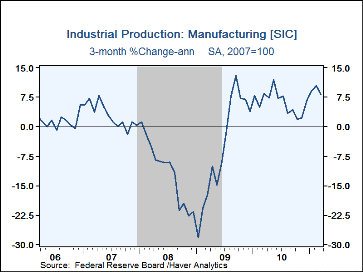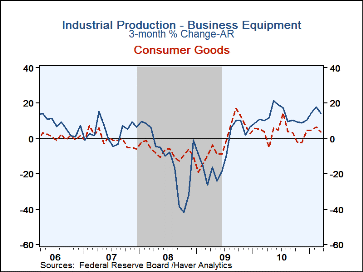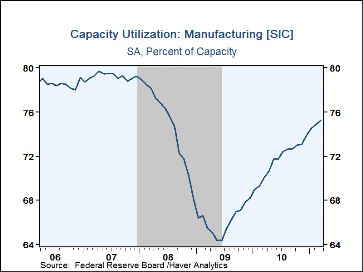 Global| Apr 15 2011
Global| Apr 15 2011U.S. Factory Sector Improvement Continues
by:Tom Moeller
|in:Economy in Brief
Summary
U.S. industrial production jumped 0.9% in March following a revised no-change in February, initially reported as -0.1%. The latest increase roughly matched Consensus expectations for a 0.8% gain according to Action Economics. Improved [...]
 U.S. industrial production jumped 0.9% in March following a revised
no-change in February, initially reported as -0.1%. The latest increase
roughly matched Consensus expectations for a 0.8% gain according to Action
Economics.
U.S. industrial production jumped 0.9% in March following a revised
no-change in February, initially reported as -0.1%. The latest increase
roughly matched Consensus expectations for a 0.8% gain according to Action
Economics.
A 2.9% increase (16.2% y/y) in motor vehicle output led last month's production gain. There was, however, significant improvement in other industry categories. Less autos, production rose 0.8% (5.2% y/y) following two months of little change. Output of high technology equipment rose 0.9% (16.9% y/y) led by a 1.9% surge (26.5% y/y) in computers & office equipment. Less both the auto and high-tech sectors, production rose 0.7% (4.9% y/y) after a 4.0% gain during all of last year. In the durables area output of primary metals gained 6.7% y/y while furniture production rose 5.2%. Amongst soft goods, plastics & rubber output rose 7.2%. Both apparel and chemical production rose 3.8%.
Capacity utilization overall rose to 77.4% and remained up sharply from the recession low of 67.3%. In manufacturing alone, utilization increased to 75.3%, up from 73.9% in December and from the recession low of 64.4%. Notable has been the rise in the computer & electronics industries to 82.3% from a low of 68.6%. Capacity slipped 0.5% y/y last month after a 2.2% drop during all of last year.
Industrial production and capacity data are included in Haver's USECON database, with additional detail in the IP database. The IP database contains figures with more decimal precision and includes extensive lists of "relative importance" numbers for several breakdowns of production by industry and market group. The expectations figure is in the AS1REPNA database.
Small Business Credit Availability is the title of yesterday's speech by Fed Governor Elizabeth A. Duke and it can be found here.
| Industrial Production (SA, % Change) | Mar | Feb | Jan | Mar Y/Y | 2010 | 2009 | 2008 |
|---|---|---|---|---|---|---|---|
| Total Output | 0.9 | 0.0 | 0.2 | 5.9 | 5.3 | -11.2 | -3.7 |
| Manufacturing | 0.7 | 0.6 | 0.8 | 6.6 | 5.4 | -13.5 | -5.0 |
| Consumer Goods | 0.9 | 0.0 | 0.0 | 4.0 | 4.3 | -7.2 | -5.2 |
| Business Equipment | 0.5 | 1.0 | 1.8 | 13.4 | 7.6 | -16.3 | -2.5 |
| Construction Supplies | 1.5 | -0.7 | 0.9 | 7.8 | 3.8 | -22.5 | -9.7 |
| Materials | 0.7 | -0.1 | -0.1 | 6.1 | 6.3 | -11.6 | -2.7 |
| Utilities | 1.7 | -3.6 | -2.2 | 1.5 | 4.0 | -2.6 | -0.1 |
| Capacity Utilization (%) | 77.4 | 76.9 | 76.9 | 72.8 | 74.5 | 69.1 | 77.8 |
| Manufacturing | 75.3 | 74.9 | 74.5 | 70.0 | 71.7 | 66.2 | 74.9 |
Tom Moeller
AuthorMore in Author Profile »Prior to joining Haver Analytics in 2000, Mr. Moeller worked as the Economist at Chancellor Capital Management from 1985 to 1999. There, he developed comprehensive economic forecasts and interpreted economic data for equity and fixed income portfolio managers. Also at Chancellor, Mr. Moeller worked as an equity analyst and was responsible for researching and rating companies in the economically sensitive automobile and housing industries for investment in Chancellor’s equity portfolio. Prior to joining Chancellor, Mr. Moeller was an Economist at Citibank from 1979 to 1984. He also analyzed pricing behavior in the metals industry for the Council on Wage and Price Stability in Washington, D.C. In 1999, Mr. Moeller received the award for most accurate forecast from the Forecasters' Club of New York. From 1990 to 1992 he was President of the New York Association for Business Economists. Mr. Moeller earned an M.B.A. in Finance from Fordham University, where he graduated in 1987. He holds a Bachelor of Arts in Economics from George Washington University.








